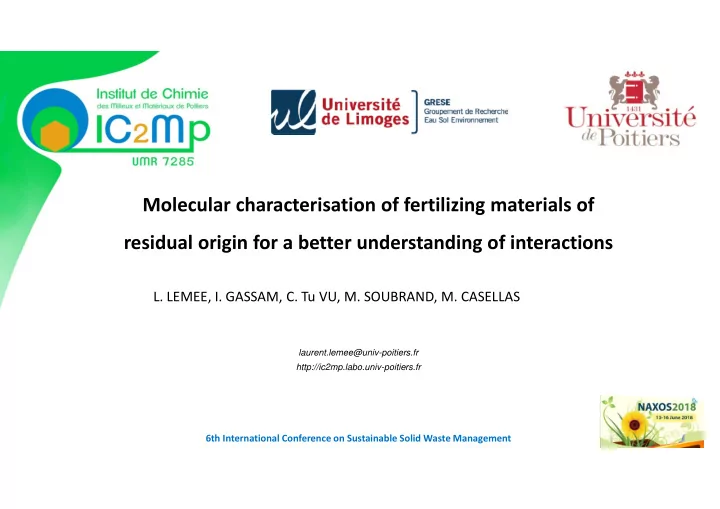

Molecular characterisation of fertilizing materials of residual origin for a better understanding of interactions L. LEMEE, I. GASSAM, C. Tu VU, M. SOUBRAND, M. CASELLAS laurent.lemee@univ-poitiers.fr http://ic2mp.labo.univ-poitiers.fr 6th International Conference on Sustainable Solid Waste Management 1
Organic w aste in France • Households : 354 kg/year/inhabitant • Sewage sludge : 20 kg / year/inhabitant NAXOS 2018 2
Landfarming Interesting solution for organic waste management - sustainable contrarily to incineration or landfill - accelerates the restoration of soils - contributes to carbon immobilization (clay-humic complexes) Naxos, june 2018 3
Hasards Presence of - pathogen micro organisms - metal trace elements (MTE) - organic micro contaminants (OMC) - antibiotics, … Contamination of soils, crops & finally human food chain Naxos, june 2018 4
Handling processes Implemented prior to land farming contribute to • degrade contaminants • produce energy • reduce the volume thus transportation cost • improve agronomic properties Naxos, june 2018 5
Objective Correlate the origin and treatment of fertilizing materials with its fate in soils Characterise residual organic materials at the global and molecular level Naxos, june 2018 6
Sam ples Thickened sludge Reed bed sludge Pig Cattle Horse manure Digested sludge Limed sludge manure manure Digested cattle manure Filtrated Centri dried 3 Composts 3 Soils Cahors, Ticol, Berneuil Andosol, Brunisol, Calcosol Naxos, june 2018 7
Elemental analysis Organic Matter (%) C/N 80 71 66 20 16,3 60 15 41 9,3 40 8,7 10 5,7 15 20 5 0 0 manures sludge compost soil manures sludges composts soils 20 80 15 60 52 50 40 10 6,3 5 20 5 0 0 digested limed digested limed decrease in OM content no improvement of C/N Naxos, june 2018 8
Chemical fractionation Lipids (mg/g OM) 200 162 150 Organic matter 100 55 53 CH 2 Cl 2 /MeOH 50 Lipids 13 0 sludge manures compost soil Biodegradable 200 Humic 150 substances 100 60 50 Refractory organic matter 50 0 cattle digested manure Weakening of OM Naxos, june 2018 9
Thermal analysis Horse manure temperature difference ( ° C/mg) 2 1 R TGA Weight loss (%) 1,1 1,2 1 0,8 0,7 0,8 0,5 0,6 0,4 0,2 0 sludge digested limed composted Temperature DSC : 2 exotherms 1 : desorption of volatiles (350 ° C) • Liming induces a weakening of OM 2 : oxidation of heavy weight compounds (500 ° C) • Composting favors humification R TGA : Weight loss associated with exo2/exo1 higher for a humified OM Limassol, Cyprus, 23 June 2016 10
Therm ochem olysis – GC/ MS mg/g OM 57 60 Pyrolysis at 3 5 0 ° C with in situ methylation (TMAH) fatty acids 50 40 molecular information on the lipidic fraction 27 30 25 19,1 20 7,8 C16 7 10 4,1 Fatty acids 1,4 1,5 1,3 C18:1 0 sludge manures compost soil C18 C16:1 aromatics C15 Steroïds C17 Raw thickened sludge Naxos, june 2018 11
Fatty acids Long/short 2,5 2 Bacterial origin C 16 1,5 iso linear 1 anteiso 0,5 0 C 18 sludges manures composts soils Branched/linear C 18:1 C 14 Plant origin 4 3,5 C 16:1 3 C 15 C 12 2,3 C 17 C 22 C 24 C 10 C 20 C 26 2 1 0,4 0,1 Digested sludge 0 sludge manures compost soil Monitor biological activity during treatment & after amendment Naxos, june 2018 12
Steroids coprostanol epicoprostanol Stanols/sterols ■ sterols □ stanols 10 8,6 cholesterol 8 cholestanol 6 4 methyl- 2,9 2 1,2 2 ethyl- 0 sludge digested limed composted Raw thickened sludge Hydrogenation of sterols during digestion Coprostanol : faecal origin • Specific biomarkers : Dehydration of sterols during composting Ergosterol : fungal origin • • Sitosterol : plant origin Naxos, june 2018 13
Conclusion Residual OM constitutes an interesting source of Carbon and N for soils All the treatments induce a loss of OM Digestion and liming weaken the OM Composting leads to a stable and humified OM with a good C/N balance Py ‐ GC/MS provides molecular information useful to envisage the fate of residual carbon in soils Naxos, june 2018 14
Thanks for your attention Naxos, june 2018 15
Recommend
More recommend